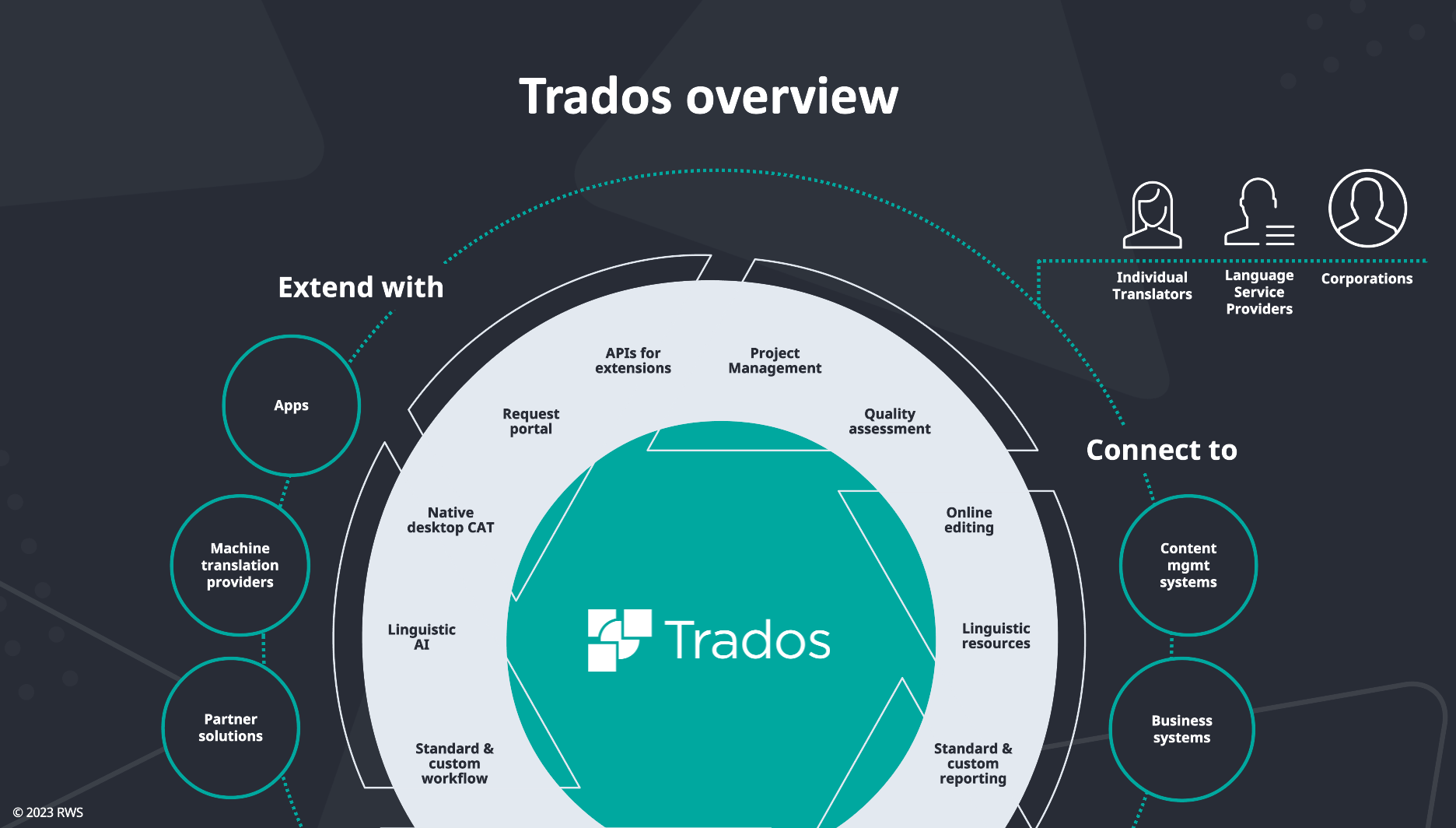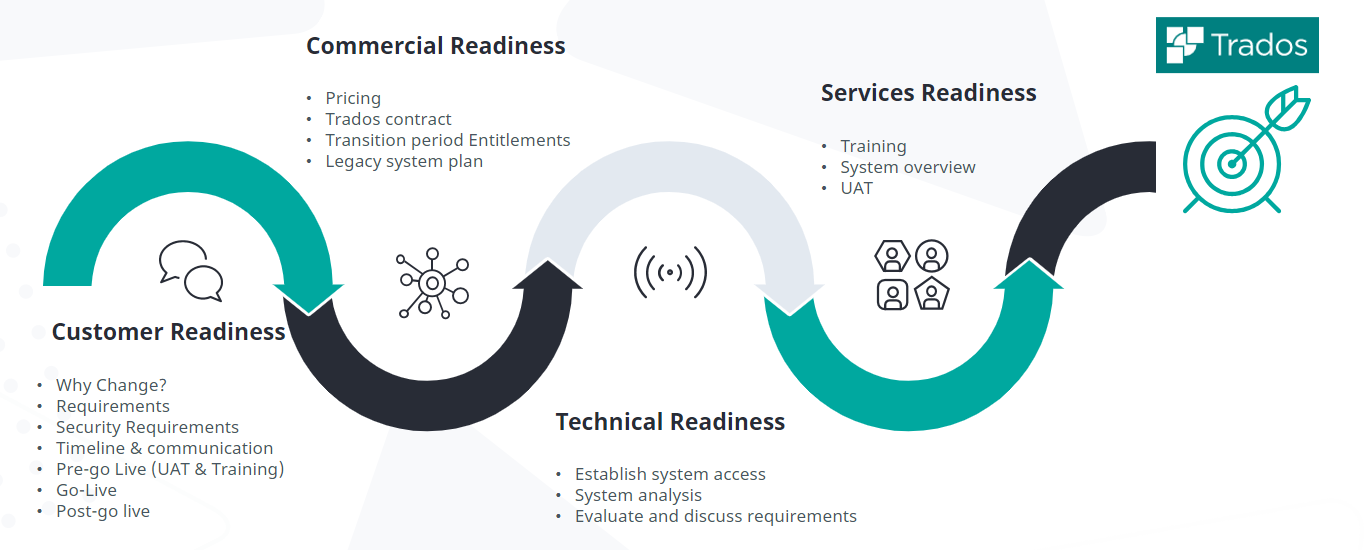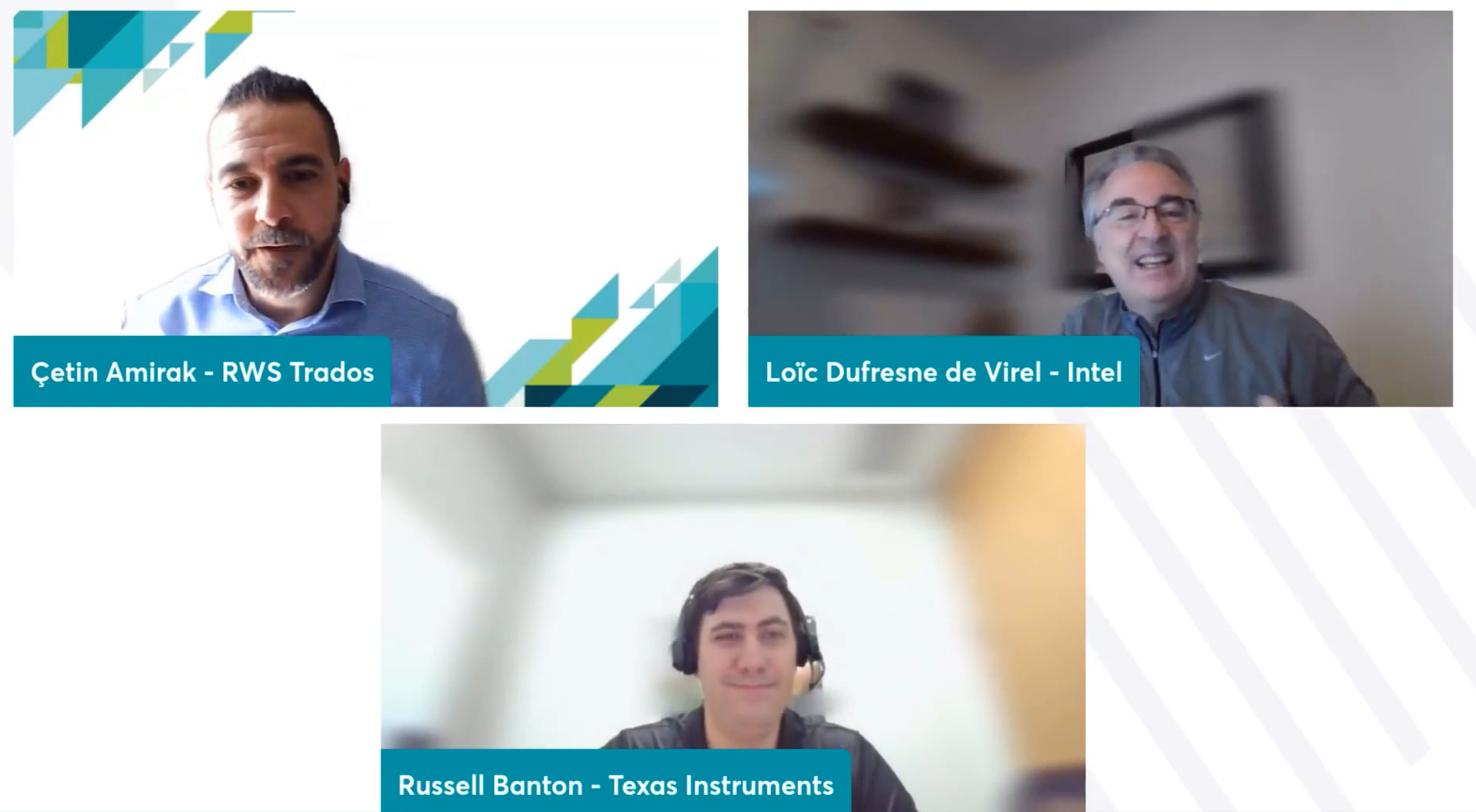The TMS conundrum: transition, migrate or do nothing? Learn how Trados makes the journey as smooth as possible
11 Aug 2023
8 mins read

As organizations continue their globalization and localization journey, they are faced with several choices: to maintain the status quo and do nothing, migrate to a different TMS, or embark on a transformative journey by transitioning their business processes and assets to the latest language technology.
With the rapid advancement of technology and evolving company requirements, the appeal of transitioning to a new localization platform becomes increasingly compelling when the existing solution fails to meet their needs. Localization requirements have grown more complex and dynamic, leaving conventional translation management features insufficient. Hence why simply doing nothing is no longer a viable option. To adapt to changing market demands and stay ahead, companies should strive to transition their business processes to an integrated, AI-enabled, automated, and comprehensive solution that accelerates time-to-market.
It is no secret that transitioning from an existing translation management system to a new system that fulfills these evolving requirements is rarely a straightforward process, so in this blog we demystify some key questions you may have.
The problem with doing nothing
There are several common reasons why simply doing nothing is a bad idea.
- Companies using proprietary systems risk being left behind, missing out on the latest advancements and improvements available in the market.
- There could be misalignment with overall technological strategy when a new cloud-based operating system or other technical infrastructure is introduced, that requires integrations the current tool cannot support.
- On premise deployments often incur high costs for hardware, hosting, license costs, maintenance and IT support.
In essence, the search for alternative solutions is driven by access to new functionalities that older solutions cannot provide, making it the preferred pathway for companies seeking to enhance their localization capabilities. However, there could be potential concerns that hold up an organization’s progress:
- What is the estimated level of effort, time commitment, and financial investment required for the migration process?
- How can resistance to change be effectively addressed and managed?
- How will the migration process impact localization productivity?
- What measures are in place to limit data loss during migration?
This is why it is important to choose the right technology provider that can make the journey as smooth as possible.
Once you decide to transition what should you look for in a TMS?
Engaging technology providers is crucial to thoroughly assess the capabilities of a solution and ensure it meets the needs of your business both in the present and the future. CSA recently hosted an insightful panel of translation managers from three different companies talking about the process they went through.
We continued the discussion at ELEVATE. I recently had a discussion with Loïc Dufresne de Virel, Manager, Localization at Intel and Russel Banton, Translation Platform Program Manager at Texas Instruments on why they decided to transition from RWS hosted TMS and on premise WorldServer to Trados Enterprise, what they have learnt from the process and why they chose Trados.
Many companies are transitioning to Trados to enhance the efficiency of their translation teams and address the increasing need for content localization. As a widely recognized industry standard in the global translation supply chain, we simplify the process, to collaborate seamlessly with internal localization teams, Language Service Providers (LSPs), and individual translators.
There are several unique drivers behind why businesses are making the switch to Trados:
- Review of business processes: Transitioning your business process to the latest translation technology will allow you to review aged processes and gives you the opportunity to modernize, optimize and standardize your localization program.
- Total cost of ownership: Our cloud-based environment means that a cloud deployment eliminates the need for expensive hardware, maintenance, and IT support. You only pay for what you need, when you need it, making it a cost-effective option for businesses of all sizes.
- Stay relevant and innovative: Our platform is constantly updated with new features and functionality. Cloud deployment benefits from these innovations immediately, enabling your business to grow and adapt as needed.
- AI: Trados incorporates our own unique Linguistic AI to speed up delivery of multilingual content. Our Linguistic AI automatically identifies the best translators and resources for every project, and routes tasks accordingly. And with AI capabilities being added at a regular pace, focusing on adding automation, improving quality and saving costs, while keeping your data secure, you can be sure to gain advantages from this new technology.
- AppStore: We own and operate the language industry’s first and only AppStore, which offers hundreds of apps to extend the functionality of your Trados software. And our extensive APIs enable developers to create new apps to meet new business needs.
- Capabilities and features: Trados encompasses all the combined features of both a TMS and CAT tool, content connectors, a modern user interface, process automation, advanced workflows, quality assessment, comprehensive support for file formats and languages, as well as out-of-the-box and customizable reporting.
- Seamless supply chain: The Trados cloud-based environment is tightly integrated with our industry-leading desktop CAT tool to bring enormous flexibility to translation management. Together, our solutions offer a unique hybrid approach to translation that inspires more agile ways of working. You have the freedom to adapt project workflows depending on the job at hand and how you prefer to work.
- Language Weaver: Translation is accelerated through integrated machine translation capabilities, including our state-of-the-art neural MT platform, Language Weaver. An annual allowance of Language Weaver is included across all Trados editions, offering over 3,500 language combinations for high-quality instant translation results from our secure cloud. Additionally, you can also access over 50 third-party MT providers directly from Trados.

Advantages of transitioning with Trados over migration
Choosing the right technology provider can make all the difference. We understand the significance of a strong partnership, especially during a change to you and your entire content and localization teams. We have formed a dedicated transition team to ensure a seamless journey as you transition to our platform.
It is important to highlight that Trados is a scalable cloud platform that forms part of an ecosystem integrating partner technologies such as business management, media transcription, and software localization. This integration enhances language solutions with advanced functionality, resulting in a streamlined and improved translation process. Our commitment to seamless operations includes daily platform updates, ensuring you effortlessly stay up to date and experience immediate benefits. Additionally, we prioritize the highest levels of information security, offering comprehensive control for risk management and customer data protection. Measures like end-to-end encryption, ISO 27001 certification, and SOC 2 compliance further reinforce the safety of your data. For more details, refer to our security white paper.
Our experienced team is readily available to provide help and guidance on important considerations prior to the transition. Here are some key areas we can help you with:
- Learn from experiences: Take this opportunity to learn from any previous shortcomings and shift your focus towards your business needs rather than relying solely on legacy setups. Embrace a fresh perspective to maximize efficiency and simplify processes. Avoid adopting a ‘lift & shift’ approach, as it may lead to failure.
- Develop a comprehensive transition plan: Understand the engagement requirements, establish a realistic timeframe for design, development, testing, training, and going live. Determine the necessary duration for accessing both legacy and new environments. Engage all relevant stakeholders who will be impacted by the transition.
- Assess your current business needs: Gain a clear understanding of your existing business requirements. Evaluate your legacy setup and identify the essential elements that need to be incorporated into the new system.
- Prioritize must-have features and capabilities: Identify the crucial features and capabilities that are essential for your operations. Include these as key factors during the assessment process to understand how the new system aligns with your requirements.
- Consider security and IT requirements: Early consideration of security and IT requirements is crucial. Validate compliance measures, as they can be extensive and may pose challenges when moving to a cloud-based solution.
- Identify pain points and benefits: Recognize the pain points in your current system and determine the potential benefits that the new solution can provide. This will enable you to build a strong business case for the transition.
- Change management & training: We understand the importance of comprehensive training and onboarding to ensure successful adoption by your team. To facilitate this, we offer a range of resources such as extensive e-learning resources that can be accessed any time, regular events and training webinars. So, you have every opportunity to discover the latest features and get the most out of Trados.

We have extensive experience in moving customers from various TMS providers to Trados, having successfully executed numerous transition projects across a wide range of TMS in the market.
Existing RWS language technology (e.g. WorldServer, TMS, GroupShare, MultiTrans) customers have a unique advantage as our process is designed to preserve the value of existing TM assets and automated translation memory migration as they transition to our leading language technology platform.
In addition, we make it easier for our existing customers to transition by offering an agreed-upon period of dual access during their transition period to Trados, free of charge, so they can focus on change management and key activities of a transition project with minimal impact to the business.
With our expertise, you can be confident that you are being guided by industry leaders, ensuring the best possible outcome for your transition. At Trados, we are committed to being with you every step of the way, ensuring your journey is as seamless as possible. We provide continuous support and regular check-ins throughout the transition process and even after the go-live stage. Our dedicated support teams are readily available to assist you with any needs or concerns that may arise.
If you’re looking to transition to an end-to-end translation solution that meets your global content localization demands and supports your growth strategy wherever you are in your journey, Trados can help you succeed.
To speak to our experts about your transition to Trados, contact us.


